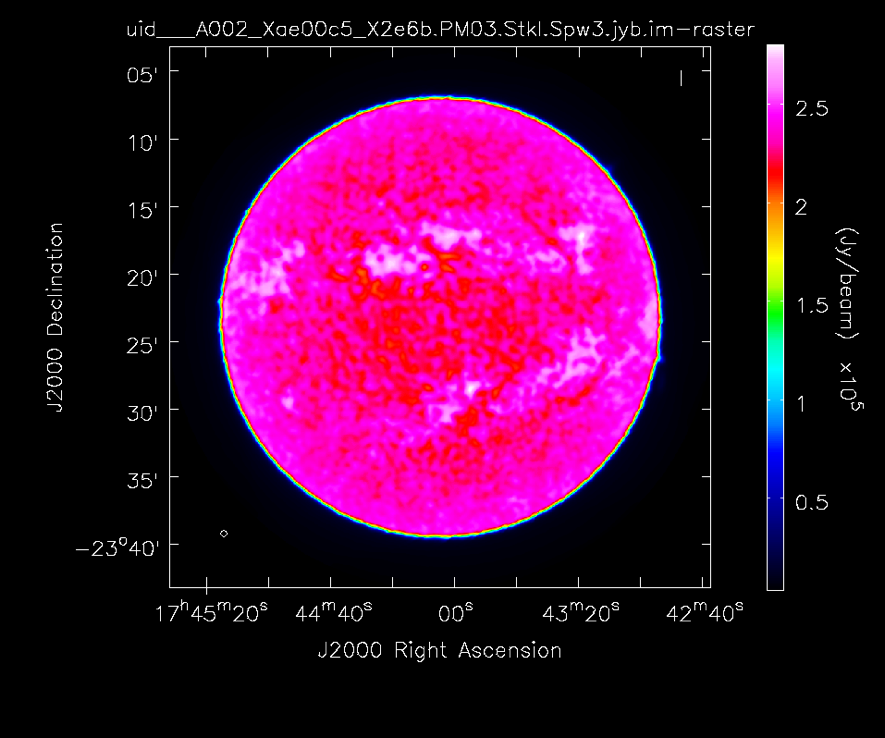Sunspot Band6 Feathering for CASA 4.7
Overview
This portion of the Sunspot Band6 CASA Guide for CASA 4.7 covers the combine process between the synthesized solar image and the full-sun image obtained with TP array. It begins where the calibration of the visibility data and single-dish data, image synthesis, and creating of the full-sun map are completed. If you do not complete them, at first,
1) Download the file of the un-calibrated data package ‘Sunspot_Band6_UncalibratedData.tgz’, do the calibration of the data, and create the images from the interferometric data and single-dish data, along with the ‘Sunspot_Band6_*_for_CASA_4.7’ tutorials.
or
2) Download the file of the calibrated data package ‘Sunspot_Band6_CalibratedData.tgz’, and synthesize the image from interferometric data along the ‘Sunspot_Band6_Imaging_for_CASA_4.7’ tutorial.
In case 1), we assume that you are working on the working directory ‘Sunspot_Band6_UncalibratedData’. On the other hand, when you started the tutorial from the calibrated package (case 2), we assume that the working directory is ‘Sunspot_Band6_CalibratedData.’
From next, we will show all commands for combining the images. If you do not want to cut-&-past the commands, you can use the script as described in #Alternative way of Combining Images.
Obtaining the RA/Dec coordinate of the sun center at the reference time
Before starting the combination process on CASA, we need to know the RA/Dec coordinate of the sun center at the reference time that is used for the image synthesis, because the observing time of the TP-array is not the same as the reference time exactly. The Sun was moving on the RA/Dec coordinate frame during the gap between the times. To combine the synthesized image with the full-sun image obtained from the TP array, we need to shift the coordinate of the full-sun image based on the coordinate of the sun center at the reference time. Hence, we obtain the solar coordinate from the JPL’s HORIZONS system[1].
The reference time in this tutorial is 19:49:00UT, December 18 2015. At the time, the RA/Dec coordinate of the sun center estimated by JPL’s HORIZONS system is RA: 266.01898 degree, Dec: -23.38648 degrees.
Preparation for Feathering task: The Single-Dish data
We start the process on CASA by defining some names of the data.
# In Casa
int_base = 'AR12470_B6AllSpw_I' # basename of the synthesized image
sd_img_base = 'uid___A002_Xae00c5_X2e6b.PM03.StkI.Spw3'
# basename of the full-sun map
out_base = 'AR12470_B6AllSpe_I_Feather' # basename of the final products
<figure id="fullsun">

</figure> We shift the coordinate of the full-sun map created from the single-dish data, based on the RA/Dec coordinate obtained in the previous section, as follows.
# In Casa
sun_ra = str(266.01898 * pi/180.)
sun_dec = str(-23.38648 * pi/180.)
imhead(imagename = sd_img_base+'.im', mode = 'put', dkey = 'crval1', hdvalue = sun_ra)
imhead(imagename = sd_img_base+'.im', mode = 'put', hdkey = 'crval2', hdvalue = sun_dec)
The unit of the full-sun map is Kelvin. On the other hand, the unit of the synthesized image is Jy/beam. So, the conversion of the unit has to be done. In the tutorial, we convert the unit of the full-sun image to Jy/beam, using the following commands.
# In Casa
crval4S= imhead(sd_img_base+'.im', mode='get',hdkey='crval4')
freqSD = crval4S.values()[0]
sbema = imhead(sd_img_base+'.im', mode='get',hdkey='beammajor')
sbemi = imhead(sd_img_base+'.im', mode='get',hdkey='beamminor')
sbmajor = sbema.values()[0]
sbminor = sbemi.values()[0]
convKJb = str(13.6 * (300./(freqSD/1.e9))**2. * (1./sbmajor)*(1./sbminor))
immath(imagename=sd_img_base+'.im', expr='IM0/'+convKJb, outfile=sd_img_base+'.jyb.im')
imhead(imagename = sd_img_base+'.jyb.im', mode = 'put', hdkey = 'crval3', hdvalue = ['I'])
imhead(imagename = sd_img_base+'.jyb.im', mode = 'put', hdkey = 'bunit', hdvalue = 'Jy/beam')
The result of the process is shown in <xr id="fullsun" />. A look of the image is not changed, but you can find the changing of the values and unit from the <xr id="fullsun" /> in ‘Sunspot_Band6_SingleDish_for_CASA_4.7’ tutorial.